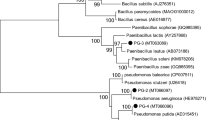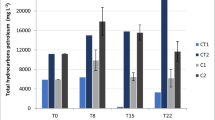Abstract
In this paper, nine strains of salt-tolerant petroleum-degrading bacteria were applied to an biological aerated filter. Simulating the degradation of high-salinity petroleum wastewater with n-hexadecane and 2,4-ditert-butylphenol as the primary pollutants and analyzing the structure of the biofilm at various salt concentrations. According to the results, when the salinity was 4%, the COD removal efficiency reached 74.34%. Various halotolerant microorganisms have adapted to various salt concentrations. At a salinity of 3%, n-hexadecane exhibited the best degradation effect, with a rate of 83.21%. Shewanella, Acinetobacter, and Marinobacter were the predominant bacterial groups at the time. At 4% salinity, Acinetobacter and Pseudomonas were the predominant bacteria, and the average 2,4-ditert-butylphenol degradation rate was the highest at 63.02%. This study provided an experimental basis for further studying the biological treatment of high-salinity petroleum wastewater.











Similar content being viewed by others
Data availability
Due to the nature of this research, no dataset was generated or analyzed during this study. Participants of this study did not agree for their data to be shared publicly, so supporting data is not available.
References
Acer, O., Guven, K., Matpan, B. F., & Gul-Guven, R. (2016). Isolation and characterization of long-chain alkane-degrading Acinetobacter sp.BT1A from oil-contaminated soil in Diyarbakır, in the Southeast of Turkey. Bioremediation Journal, 20(1), 80–87. https://doi.org/10.1080/10889868.2015.1096898
Atkinson, G. M., Eaton, D. W., Ghofrani, H., Walker, D., Cheadle, B., Schultz, R., Shcherbakov, R., Tiampo, K., Gu, J., Harrington, R. M., Liu, Y., van der Baan, M., & Kao, H. (2016). Hydraulic fracturing and seismicity in the western Canada sedimentary basin. Seismological Research Letters, 87(3), 631–647. https://doi.org/10.1785/0220150263
Campos, J. C., Borges, R. M. H., Oliveira Filho, A. M., Nobrega, R., & Sant’Anna, G. L. (2002). Oilfield wastewater treatment by combined microfiltration and biological processes. Water Research, 36(1), 95–104. https://doi.org/10.1016/S0043-1354(01)00203-2
Camus, L., Brooks, S., Geraudie, P., Hjorth, M., Nahrgang, J., Olsen, G. H., & Smit, M. G. D. (2015). Comparison of produced water toxicity to Arctic and temperate species. Ecotoxicology and Environmental Safety, 113, 248–258. https://doi.org/10.1016/j.ecoenv.2014.12.007
Cappello, S., et al. (2016). Oil-degrading bacteria from a membrane bioreactor (BF-MBR) system for treatment of saline oily waste: Isolation, identification and characterization of the biotechnological potential. International Biodeterioration and Biodegradation, 110, 235–244. https://doi.org/10.1016/j.ibiod.2015.12.028
Chandra, S., et al. (2013). Application of bioremediation technology in the environment contaminated with petroleum hydrocarbon. Annals of Microbiology, 63(2), 417–431. https://doi.org/10.1007/s13213-012-0543-3
Cortés-Lorenzo, C., Sipkema, D., Rodríguez-Díaz, M., Fuentes, S., Juárez-Jiménez, B., Rodelas, B., Smidt, H., & González-López, J. (2014). Microbial community dynamics in a submerged fixed bed bioreactor during biological treatment of saline urban wastewater. Ecological Engineering, 71(1), 126–132. https://doi.org/10.1016/j.ecoleng.2014.07.025
Cui, Z., Lai, Q., Dong, C., & Shao, Z. (2008). Biodiversity of polycyclic aromatic hydrocarbon-degrading bacteria from deep sea sediments of the Middle Atlantic Ridge. Environmental Microbiology, 10(8), 2138–2149. https://doi.org/10.1111/j.1462-2920.2008.01637.x
Dao, L., Grigoryeva, T., Laikov, A., Devjatijarov, R., & Ilinskaya, O. (2014). Full-scale bioreactor pretreatment of highly toxic wastewater from styrene and propylene oxide production. Ecotoxicology and Environmental Safety, 108, 195–202. https://doi.org/10.1016/j.ecoenv.2014.07.012
Ekins, P., Vanner, R., & Firebrace, J. (2007). Zero emissions of oil in water from offshore oil and gas installations: Economic and environmental implications. Journal of Cleaner Production, 15(13–14), 1302–1315. https://doi.org/10.1016/j.jclepro.2006.07.014
Gulyas, H., & Reich, M. (2000). Organic constituents of oil reclaiming wastewater. Journal of Environmental Science and Health, Part A, 35(4), 435–464. https://doi.org/10.1080/10934520009376981
Guo, Q. (2016). The research of screening and degradating optimization of oil reduction bacteria in oil wastewater. Xi’An Polytechnic University.
Hassanshahian, M., Ahmadinejad, M., Tebyanian, H., & Kariminik, A. (2013). Isolation and characterization of alkane degrading bacteria from petroleum reservoir waste water in Iran (Kerman and Tehran provenances). Marine Pollution Bulletin, 73(1), 300–305. https://doi.org/10.1016/j.marpolbul.2013.05.002
He, Y. M., Duan, X. G., & Liu, Y. S. (2014). Enhanced bioremediation of oily sludge using co-culture of specific bacterial and yeast strains. Journal of Chemical Technology and Biotechnology, 89(11), 1785–1792. https://doi.org/10.1002/jctb.4471
Huang, G., Meng, F., Zheng, X., Wang, Y., Wang, Z., Liu, H., & Jekel, M. (2011). Biodegradation behavior of natural organic matter (NOM) in a biological aerated filter (BAF) as a pretreatment for ultrafiltration (UF) of river water. Applied Microbiology and Biotechnology, 90(5), 1795–1803. https://doi.org/10.1007/s00253-011-3251-1
Iwama, G. K. (1991). Interactions between aquaculture and the environment. Critical Reviews in Environmental Control, 21(2), 177–216. https://doi.org/10.1080/10643389109388413
Jimoh, A. A., & Lin, J. (2021). Degradative enzymes and biosurfactant mediated mechanism of diesel fuel and n-hexadecane biodegradation by Paenibacillus sp. D9. Bioremediation Journal, 1–13. https://doi.org/10.1080/10889868.2021.1974816
Khemili-Talbi, S., Kebbouche-Gana, S., Akmoussi-Toumi, S., Angar, Y., & Gana, M. L. (2015). Isolation of an extremely halophilic arhaeon Natrialba sp. C21 able to degrade aromatic compounds and to produce stable biosurfactant at high salinity. Extremophiles: Life under Extreme Conditions, 19(6), 1109–1120. https://doi.org/10.1007/s00792-015-0783-9
Kong, F., & Wang, X. (2017). Halophilic microoganisms in salt lakes on Tibet Plateau and their potential application. Science and Technology Review, 35(12), 27–31. https://doi.org/10.13376/j.cbls/2018015
Liang, Q. (2011). Antarctic offshore petroleum hydrocarbon cryodegradation bacteria Shewanella sp. NJ49 oxygenase and its genetic research. The First Institute of Oceanography of the State Oceanic Administration.
Liu, H. J., et al. (2014). Isolation and characterization of crude-oil-degrading bacteria from oil–water mixture in Dagang oil field, China. Internationa Biodeterioration & Biodegradation, 87, 52–59. https://doi.org/10.1016/j.ibiod.2013.11.005
Liu, Z., et al. (2019). Research progresses on bioremediation of petroleum contaminated shoreline. Modern Chemical Industry, 39(08), 78–82. https://doi.org/10.16606/j.cnki.issn0253-4320.2019.08.016
Liu, Y. S., et al. (2022). Biological process of alkane degradation by Gordonia sihwaniensis. ACS Omega, 7(1), 55–63. https://doi.org/10.1021/acsomega.1c01708
Mahjoubi, M., Jaouani, A., Guesmi, A., Ben Amor, S., Jouini, A., Cherif, H., Najjari, A., Boudabous, A., Koubaa, N., & Cherif, A. (2013). Hydrocarbonoclastic bacteria isolated from petroleum contaminated sites in Tunisia: Isolation, identification and characterization of the biotechnological potential. New Biotechnology, 30(6), 723–733. https://doi.org/10.1016/j.nbt.2013.03.004
Mao, X., & Guo, J. (2018). Functional protein research progression in extremophiles. Chinese Bulletin of Life Sciences, 30(01), 107–112. https://doi.org/10.13376/j.cbls/2018015
Medić, A., Lješević, M., Inui, H., Beškoski, V., Kojić, I., Stojanović, K., & Karadžić, I. (2020). Efficient biodegradation of petroleum n-alkanes and polycyclic aromatic hydrocarbons by polyextremophilic Pseudomonas aeruginosa san ai with multidegradative capacity. RSC Advances, 10(24), 14060–14070. https://doi.org/10.1039/c9ra10371f
Office, E. (2003). Book Information: The newly published《Analytical Methods for Water and Wastewater Monitoring 》. Environmental Monitoring in China (4th ed) is now being published, 19(1), 4. https://doi.org/10.3969/j.issn.1002-6002.2003.01.027
Olajuyigbe, F. M., Ehiosun, K. I., & Jaiyesimi, K. F. (2015). Preliminary study towards enhanced crude oil biodegradation reveals congeneric total peroxidases with striking distinctions. Advances in Enzyme Research, 03(3), 66–74. https://doi.org/10.4236/aer.2015.33007
Shahi, A., Aydin, S., Ince, B., & Ince, O. (2016). Evaluation of microbial population and functional genes during the bioremediation of petroleum-contaminateds oil asan effective monitoring approach. Ecotoxicology and Environmental Safety, 125, 153–160. https://doi.org/10.1016/j.ecoenv.2015.11.029
Shang, B., et al. (2015). Advances in Shewanella spp. Fujian. Agriculture, 7, 152–154.
Shi, L., et al. (2014). Diversity of cultivable bacteria in activated sludge of an oil-field’s wastewater treatment system. Environmental Science and Technology, 37(6), 38–43.
Shishir, T. A., Mahbub, N., & Kamal, N. E. (2019). Review on bioremediation: A tool to resurrect the polluted rivers. Pollution, 5(3), 555–568. https://doi.org/10.22059/poll.2019.272339.558
Speight, J. G. (2007). The chemistry and technology of petroleum. Marcel Dekker.
Tang, X., He, L. Y., Tao, X. Q., Dang, Z., Guo, C. L., Lu, G. N., & Yi, X. Y. (2010). Construction of an artificial microalgal-bacterial consortium that efficiently degrades crude oil. Journal of Hazardous Materials, 181(1–3), 1158–1162. https://doi.org/10.1016/j.jhazmat.2010.05.033
Teng, Y., Jiang, L., Yu, M., Gu, G., & Li, Z. (2019). Study on treatment of domestic wastewater by biological aerated filter. IOP Conference Series: Earth and Environmental Science, 330(3), 032054. https://doi.org/10.1088/1755-1315/330/3/032054
Varjani, S. J., & Upasani, V. N. (2017). A new look on factors affecting microbial degradation of petroleum hydrocarbon pollutants. International Biodeterioration and Biodegradation, 120, 71–83. https://doi.org/10.1016/j.ibiod.2017.02.006
Wang, Y. N., Chi, C. Q., Cai, M., Lou, Z. Y., Tang, Y. Q., Zhi, X. Y., Li, W. J., Wu, X. L., & Du, X. (2010). Amycolicicoccus subflavus gen. nov., sp nov., an actinomycete isolated from a saline soil contaminated by crude oil. International Journal of Systematic and Evolutionary Microbiology. Part, 60(3), 638–643.
Wang, S., et al. (2011). Screening and identification of diesel fuel degrading microorganism. Journal of Agro-Environment Science, 30(1), 49–54.
Wang, W., Zhang, R., Shan, D., & Shao, Z. (2014b). Erratum to: Indigenous oil-degrading bacteria in crude oil-contaminated seawater of the Yellow Sea. China. Applied Microbiology and Biotechnology, 98(16), 7281. https://doi.org/10.1007/s00253-014-5922-1
Wang, M., Liu, Y., & Deng, F. (2014a). A process for treating high salinity oil exploitation wastewater by halophilic bacteria and SBR. Environmental Protection of Oil and Gas Fields, 24(5), 37–38, 84.
Wu, T., et al. (2012). Surface activity of salt-tolerant Serratia spp. and crude oil biodegradation in saline soil. Plant Soil and Enviroment, 58(9), 412–416. https://doi.org/10.17221/217/2012-PSE
Xu, J., et al. (2007). Isolation of petroleum degradation bacteria and its application to bioremediation of petroleum-contaminated soil. Acta Scientiae Circumstantiae, 27(4), 622–628.
Yan, J., & Xie, J. (2020). Advances in Shewanella spp biofilm. Journal of Microbiology, 40(5), 104–111.
Zhang, Y., Li, B., Xu, R. X., Wang, G. X., Zhou, Y., & Xie, B. (2016). Effects of pressurized aeration on organic degradation efficiency and bacterial community structure of activated sludge treating saline wastewater. Bioresource Technology, 222(1), 182–189. https://doi.org/10.1016/j.biortech.2016.10.005
Zhao, W., et al. (2013). Denitrification activities and N2O production under salt stress with varying COD/N ratios and terminal electron acceptors. Chemical Engineering Journal, 215–216, 252–260. https://doi.org/10.1016/j.cej.2012.10.084
Funding
This work was supported by Tianjin Science and Technology Planning Project (22YDTPJC00760), Technology Innovation Guidance Special (Fund) (20YDTPJC01790), Tianjin Key R&D Program—Social Development and Agriculture Project (21YFSNSN00190) and National Key R&D Program ‘Technology Boosts Economy 2020’ Key Special Project (SQ2020YFF0401503), Tianjin Science and Technology Planning Project (18ZXSZSF00090), and Tianjin Technology Innovation Guidance Project (No. 20YDTPJC00150).
Author information
Authors and Affiliations
Contributions
Shiling Liu: writing—original draft, writing—review and editing; Wenjiao Yuan: formal analysis, funding acquisition; Xiaolin Yang, Chengbin Li, Yishan Ji: investigation; Xin Feng, Meitong Li: funding acquisition; Yuhong Xie: conceptualization and methodology, writing—original draft, writing—review and editing; all authors reviewed the manuscript.
Corresponding authors
Ethics declarations
Ethical approval
All authors have read, understood, and have complied as applicable with the statement on "Ethical Responsibilities of Authors" as found in the Instructions for Authors and are aware that with minor exceptions, no changes can be made to authorship once the paper is submitted.
Competing interests
The authors declare no competing interests.
Additional information
Publisher's note
Springer Nature remains neutral with regard to jurisdictional claims in published maps and institutional affiliations.
Rights and permissions
Springer Nature or its licensor (e.g. a society or other partner) holds exclusive rights to this article under a publishing agreement with the author(s) or other rightsholder(s); author self-archiving of the accepted manuscript version of this article is solely governed by the terms of such publishing agreement and applicable law.
About this article
Cite this article
Liu, S., Yuan, W., Yang, X. et al. Microbial degradation of petroleum characteristic pollutants in hypersaline environment, emphasizing n-hexadecane and 2,4 di-tert-butylphenol. Environ Monit Assess 195, 771 (2023). https://doi.org/10.1007/s10661-023-11362-y
Received:
Accepted:
Published:
DOI: https://doi.org/10.1007/s10661-023-11362-y




